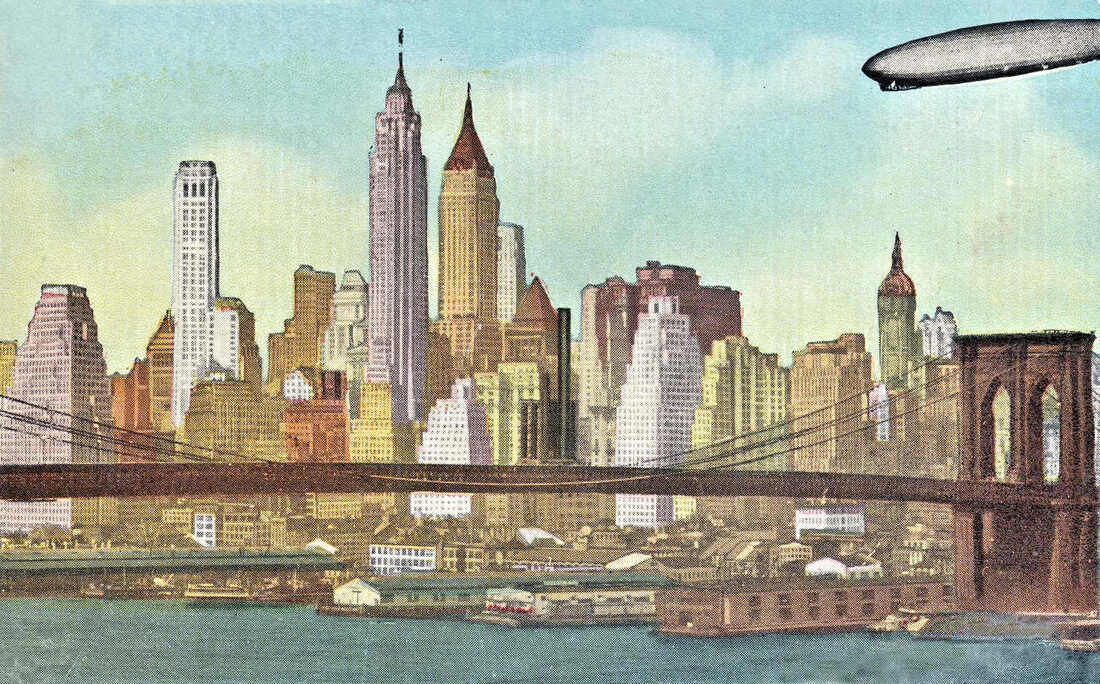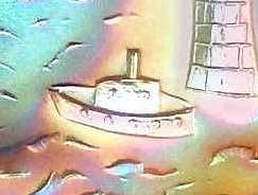The Day New York Went Crazy.
Based on a 2012 collaborative article about the Brooklyn Bridge Carnival Glass pattern, by Glen & Stephen Thistlewood and Mike Brown.
Updated in August 2023, using additional and extensive research.
Updated in August 2023, using additional and extensive research.
|
Picture it! New York at the height of the Jazz Age, August 1929.
The summer heat beats down on the streets of Lower Manhattan as all eyes turn skywards. Thousands fill the parks and open spaces. In the streets drivers brake hard, jump out of their vehicles and scramble onto their car roofs to get a better view as the massive yet elegant form of the Graf Zeppelin airship glides overhead. The crowds shout in anticipation then turn silent in awe as the dirigible soars by. Boats packed with reporters and sight-seers coast along the East River as the Zeppelin flies over the Brooklyn Bridge, returning to New York after its first Round-the-World Flight. |
Above: an old postcard showing a blimp over the Brooklyn Bridge, New York.
|
A reporter tells the world “New York has gone crazy!” while newspaper headlines shout out that the “Daring Dash Round The World Established New Records”. It wasn’t the first time the Graf Zeppelin had soared over New York: just ten months earlier she had made the first Transatlantic flight of an airship. New Yorkers had gone wild, and a ticker-tape parade on Broadway saw many thousands cheering the crew. Massive press coverage was given to these achievements and the public were wildly enthusiastic about it all. The “Lindbergh Boom” in aviation that had begun in 1927 saw increasing popularity and an insatiable thirst from the public for more. New York was buzzing with excitement.
The postcard (above right) will have given the reader an idea of how this links up with Carnival Glass; via the Brooklyn Bridge bowl, of course!
Let’s look at the glass and its design inspiration.
The Brooklyn Bridge bowls were made at the Diamond Glassware Co. (formerly Dugan Glass Company) in Indiana, PA. Contemporary accounts suggest that the factory was still introducing new lines and working well during the latter part of the 1920s, but there were certainly some difficulties too, indicated by intermittent reductions in working hours. It is around this time that the mould for the Brooklyn Bridge bowl was surely made. The design was fairly simple and easy to create, cutting the pattern onto the plunger was probably not too tricky and with no exterior design, it wouldn’t have been especially hard to do.
The arrival of the Graf Zeppelin over New York in 1929 “narrated” by the Carnival Glass design was a massive event. The management at Diamond Glassware probably believed they would have a best-seller on their hands with this new design - the image of the blimp overflying New York's iconic Brooklyn Bridge. Surely a winner, especially as the economy was riding high.
The Brooklyn Bridge Carnival Glass bowl was made mainly in marigold, with a few examples in "pink afterglow". There is one example reported - but unverified - in vaseline. They are found only as ruffled bowls, with 6 or 10 ruffles (roughly one third are 6 ruffled); an 8 ruffled version is reported, but unverified. There is also an unlettered version (without the Brooklyn Bridge lettering), but examples of it are very rare.
Most likely the unlettered version was first to be made: could the wording have been added to not only capitalise on the phenomenal public interest and publicity surrounding the Graf Zeppelin’s flight (it had thrilled thousands upon thousands, flying over San Francisco, Chicago, Kansas City, Detroit and more en route to New York), but also in anticipation of the upcoming Golden Jubilee of the Brooklyn Bridge in 1933?
|
The design features, in cameo, a blimp over the familiar form of the famous bridge, with BROOKLYN BRIDGE written below the airship. The boats under the bridge in the design (right) are surely representations of the East River tug boats of the time. There is a contemporary newsreel (more on this later) showing boats packed full of press men, straining to get the best view of the Zeppelin, shouting excitedly, scribbling notes for late night editions.
|
So why is the Brooklyn Bridge bowl fairly hard to find? Why isn’t it as plentiful as Double Stem Rose and Pony bowls? Maybe the answer is all in the timing.
"Events, Dear Boy, Events!" (to quote Rab Butler, British Home Secretary).
Within a week after that momentous day in August, 1929, the US stock market reached an all time high. Life was good, stocks and shares were soaring upwards, just like the airships. But bad times were just around the corner, as only a few short weeks later came the Wall Street Crash. On Black Thursday, just 8 weeks after the Graf Zeppelin had cruised jubilantly over New York, share prices fell. Panic and chaos took over, and the bubble had burst. The awful effects of the Great Depression were beginning to ripple through all sectors of the population. It is very possible that the market for a Carnival Glass souvenir bowl suddenly looked very shaky. Worse still, in 1931, the Diamond factory suffered a devastating fire, and in the clear-up afterwards, boxes of Brooklyn Bridge bowls had been found.
It’s possible that those boxes of bowls had been stored safely away in anticipation of the upcoming 1933 Brooklyn Bridge Jubilee – and as luck would have it, they were saved from the fire. Although those bowls survived, sadly the Diamond Glassware Company did not. Immediately after the fire there had been some hope that there would be rebuilding – but the economic situation was not favourable and soon the factory doors were closed for good. It’s fascinating to ponder the social and economic history, as well as the technical advancements (both the amazing structure of the Brooklyn Bridge and the Graf Zeppelin) that are depicted and reflected on this unique piece of Carnival Glass.
Within a week after that momentous day in August, 1929, the US stock market reached an all time high. Life was good, stocks and shares were soaring upwards, just like the airships. But bad times were just around the corner, as only a few short weeks later came the Wall Street Crash. On Black Thursday, just 8 weeks after the Graf Zeppelin had cruised jubilantly over New York, share prices fell. Panic and chaos took over, and the bubble had burst. The awful effects of the Great Depression were beginning to ripple through all sectors of the population. It is very possible that the market for a Carnival Glass souvenir bowl suddenly looked very shaky. Worse still, in 1931, the Diamond factory suffered a devastating fire, and in the clear-up afterwards, boxes of Brooklyn Bridge bowls had been found.
It’s possible that those boxes of bowls had been stored safely away in anticipation of the upcoming 1933 Brooklyn Bridge Jubilee – and as luck would have it, they were saved from the fire. Although those bowls survived, sadly the Diamond Glassware Company did not. Immediately after the fire there had been some hope that there would be rebuilding – but the economic situation was not favourable and soon the factory doors were closed for good. It’s fascinating to ponder the social and economic history, as well as the technical advancements (both the amazing structure of the Brooklyn Bridge and the Graf Zeppelin) that are depicted and reflected on this unique piece of Carnival Glass.
|
Recording the arrival of the Graf Zeppelin There are various contemporaneous records of this amazing event, including even a "spoof" picture. Take a look at the photographic image below, of an airship apparently docking on the top of the Empire State Building. This image is in fact a “fake” (think “photo shop”)! Originally, the building was going to have a flat roof, but the owners redesigned it to have a 200 foot high mooring mast. Was this a serious proposal, or just a publicity stunt to give the building extra height and gain the title of the World's Tallest Building (at least for a while)? The mooring mast was however actually built (so King Kong was able to make dramatic use of it later!), giving the building its iconic profile to this very day.
|
|
The 1929 newsreel There is an amazing piece of archive newsreel footage on YouTube showing the return of the Graf Zeppelin to New York. It lasts about 7 minutes. There is one section where the photographer, shown here on the right, moves along the girder with his very heavy and cumbersome tripod camera, presumably to get a better, unobstructed view from way up high - a heart-stopping moment! A truly unbelievable piece of historic newsreel footage and one that is definitely not to be missed! Here is the link to the video on YouTube: Graf Zeppelin over New York |
Read More Stories Behind the Glass on Carnival Glass Times










